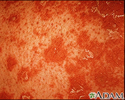Pityriasis rubra pilaris
Pityriasis rubra pilaris is a rare skin disorder that causes constant inflammation and scaling (exfoliation) of the skin.
Scaling
Scales are a visible peeling or flaking of outer skin layers. These layers are called the stratum corneum.

Causes
There are many different types of pityriasis rubra pilaris. The cause is unknown, although genetic factors, an abnormal immune response, or vitamin A deficiency may be involved.
Symptoms
Pityriasis rubra pilaris is a chronic (life-long) skin condition in which orange-red scaly patches, and thick skin develop on the hands and feet.
The scaly areas cover much of the body. Small islands of normal skin (islands of sparing) are seen within the areas of the scaly skin. The scaly areas may be itchy. There may be changes in the nails.
Exams and Tests
The health care provider will examine your skin. Diagnosis is usually made because of the unique skin lesions. (A lesion is an abnormal area on the skin).
Treatment
Topical creams containing urea, lactic acid, retinoids, and steroids may help. More commonly, treatment includes pills taken by mouth such as isotretinoin, acitretin, or methotrexate. Exposure to ultraviolet light (light therapy) may also help.
When to Contact a Medical Professional
Call your health care provider if you develop symptoms of pityriasis rubra pilaris. Also call if you have the disorder and symptoms worsen.
References
James WD, Berger TG, Elston DM. Pityriasis rosea, pityriasis rubra pilaris, and other papulosquamous and hyperkeratotic diseases. In: James WD, Berger TG, Elston DM, eds. Andrews' Diseases of the Skin: Clinical Dermatology . 12th ed. Philadelphia, PA: Elsevier; 2016:chap 11.
Tobin AM, Kirby B. Pityriasis rubra pilaris. In: Lebwohl MG, Heymann WR, Berth-Jones J, Coulson I, eds. Treatment of Skin Disease: Comprehensive Therapeutic Strategies . 4th ed. Philadelphia, PA: Elsevier Saunders; 2014:chap 187.
-
Pitted keratolysis - illustration
This picture shows pitted, flesh colored "pits" (keratolysis) or depressions on the soles of the feet, associated with a bad odor (mal-odor). This is thought to be caused by overgrowth of diptheroids and micrococcus.
Pitted keratolysis
illustration
-
Pityriasis rubra pilaris on the chest - illustration
This person has pityriasis rubra pilaris on the chest, an uncommon skin condition characterized by salmon-colored patches with scaling (palmoplantar keratoderma). A characteristic sign of pityriasis rubra pilaris is plugging of the hair follicles with keratin. This picture illustrates areas of uninvolved skin (islands of sparing) surrounded by areas of redness (erythroderma).
Pityriasis rubra pilaris on the chest
illustration
-
Pityriasis rubra pilaris on the feet - illustration
This is a picture of pityriasis rubra pilaris on the feet. It is an uncommon skin condition characterized by thick scales and salmon-colored patches.
Pityriasis rubra pilaris on the feet
illustration
-
Pityriasis rubra pilaris on the palms - illustration
This is a picture of pityriasis rubra pilaris on the palms. This is an uncommon skin condition characterized by salmon-colored patches with scaling (palmoplantar keratoderma).
Pityriasis rubra pilaris on the palms
illustration
-
Pityriasis rubra pilaris - close-up - illustration
Pityriasis rubra pilaris is an uncommon skin condition. It is characterized by salmon-colored patches with scaling, clear areas of normal skin, and thick palms and soles. Hair follicles with keratin plugging is a characteristic sign. Typically the follicle is surrounded with a characteristic orange-red color.
Pityriasis rubra pilaris - close-up
illustration
-
Pitted keratolysis - illustration
This picture shows pitted, flesh colored "pits" (keratolysis) or depressions on the soles of the feet, associated with a bad odor (mal-odor). This is thought to be caused by overgrowth of diptheroids and micrococcus.
Pitted keratolysis
illustration
-
Pityriasis rubra pilaris on the chest - illustration
This person has pityriasis rubra pilaris on the chest, an uncommon skin condition characterized by salmon-colored patches with scaling (palmoplantar keratoderma). A characteristic sign of pityriasis rubra pilaris is plugging of the hair follicles with keratin. This picture illustrates areas of uninvolved skin (islands of sparing) surrounded by areas of redness (erythroderma).
Pityriasis rubra pilaris on the chest
illustration
-
Pityriasis rubra pilaris on the feet - illustration
This is a picture of pityriasis rubra pilaris on the feet. It is an uncommon skin condition characterized by thick scales and salmon-colored patches.
Pityriasis rubra pilaris on the feet
illustration
-
Pityriasis rubra pilaris on the palms - illustration
This is a picture of pityriasis rubra pilaris on the palms. This is an uncommon skin condition characterized by salmon-colored patches with scaling (palmoplantar keratoderma).
Pityriasis rubra pilaris on the palms
illustration
-
Pityriasis rubra pilaris - close-up - illustration
Pityriasis rubra pilaris is an uncommon skin condition. It is characterized by salmon-colored patches with scaling, clear areas of normal skin, and thick palms and soles. Hair follicles with keratin plugging is a characteristic sign. Typically the follicle is surrounded with a characteristic orange-red color.
Pityriasis rubra pilaris - close-up
illustration
Review Date: 4/14/2015
Reviewed By: Kevin Berman, MD, PhD, Atlanta Center for Dermatologic Disease, Atlanta, GA. Review provided by VeriMed Healthcare Network. Also reviewed by David Zieve, MD, MHA, Isla Ogilvie, PhD, and the A.D.A.M. Editorial team.





